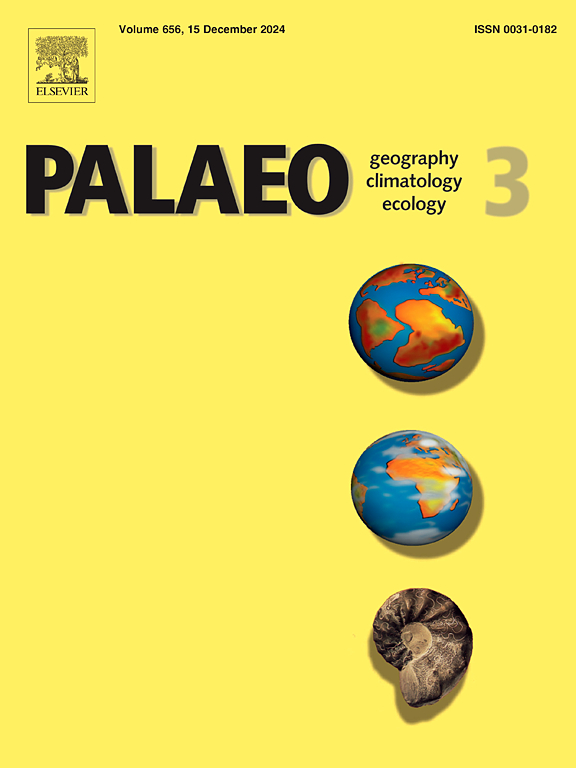Filling the gap of the late Quaternary planktonic foraminifera record in the Western Mediterranean: Paleoceanographic changes in the Ligurian Sea over the last 27.4 ka
IF 2.7
2区 地球科学
Q2 GEOGRAPHY, PHYSICAL
Palaeogeography, Palaeoclimatology, Palaeoecology
Pub Date : 2025-06-06
DOI:10.1016/j.palaeo.2025.113078
引用次数: 0
Abstract
This study aims to expand our understanding of the paleoceanographic changes in the western Mediterranean during the Late Quaternary by investigating the planktonic foraminifera and the reworked coccolith records of the NDT_22_2016 core (27.4 ka cal BP to present) in the Ligurian Sea. To achieve this a robust age model was developed using 17 radiocarbon dates, allowing sub-millennial resolution analyses. The last glacial period (115–11.7 ka cal BP) was characterized by cold-eutrophic species (Globigerinita glutinata, Globigerina bulloides and Turborotalita quinqueloba), while formation of a seasonal deep chlorophyll maximum (DCM) was confined to the south-western Mediterranean as testified by the distribution of Neogloboquadrina incompta. The intervening Heinrich events were identified in the Ligurian Sea through reworked coccolith peaks and the subsequent increase of N. incompta, indicating enhanced runoff and DCM formation, respectively, in response to a northward expansion of the summer warming. Subsequently, during deglaciation, intense warming initiating with the Bølling-Allerød, and interrupted during the Younger Dryas, led to an increase in the abundance of Globoconella inflata, suggesting year-round stratification. The Holocene was subdivided in three phases: an initial rapid warming (up to 10.4 ka cal BP), followed by the development of strong stratification during the second phase (10.4–5.3 ka cal BP), which includes the time interval of sapropel S1 in the Eastern Mediterranean. The second to third phase transition is marked by the appearance of Globorotalia truncatulinoides, signalling a strong seasonal contrast, characterized by strong winter mixing and summer stratification as evidenced also by the presence of N. incompta.
填补西地中海晚第四纪浮游有孔虫记录的空白:利古里亚海过去27.4 ka的古海洋学变化
本文通过对利古里亚海NDT_22_2016岩心(至今27.4 ka cal BP)浮游有孔虫和球粒岩心的重新加工记录的研究,扩大了对西地中海晚第四纪古海洋学变化的认识。为了实现这一目标,研究人员利用17个放射性碳年代建立了一个稳健的年龄模型,允许进行次千年分辨率的分析。末次冰期(115-11.7 ka cal BP)以冷富营养化物种(gloigerinita glutinata、gloigerina bulloides和Turborotalita quinqueloba)为特征,而季节性深叶绿素最大值(DCM)的形成仅限于地中海西南部,如Neogloboquadrina incompta的分布。在利古里亚海,通过对球岩石峰的重新加工和随后的N. incompta的增加,确定了海因里希事件的介入,分别表明径流和DCM形成的增加是对夏季变暖北向扩展的响应。随后,在冰川消退期间,从b ølling- allero ød开始的强烈变暖,在新仙女木时期中断,导致Globoconella inflata丰度增加,表明全年分层。全新世可分为三个阶段:最初的快速升温阶段(最高达10.4 ka cal BP),随后是第二阶段(10.4 - 5.3 ka cal BP)的强分层发展阶段,这一阶段包括东地中海S1期的时间间隔。第二到第三阶段的转变以Globorotalia truncatulinoides的出现为标志,标志着强烈的季节对比,其特征是强烈的冬季混合和夏季分层,这也由N. incompta的存在证明。
本文章由计算机程序翻译,如有差异,请以英文原文为准。
求助全文
约1分钟内获得全文
求助全文
来源期刊
CiteScore
5.90
自引率
10.00%
发文量
398
审稿时长
3.8 months
期刊介绍:
Palaeogeography, Palaeoclimatology, Palaeoecology is an international medium for the publication of high quality and multidisciplinary, original studies and comprehensive reviews in the field of palaeo-environmental geology. The journal aims at bringing together data with global implications from research in the many different disciplines involved in palaeo-environmental investigations.
By cutting across the boundaries of established sciences, it provides an interdisciplinary forum where issues of general interest can be discussed.

 求助内容:
求助内容: 应助结果提醒方式:
应助结果提醒方式:


